
Sep 1, 2015
In a somewhat remote portion of Nevada County, on San Juan Ridge, lies the ‘Inimim Forest. It consists of ten parcels of public land totaling about 1,800 acres. Each parcel of government land is surrounded by private property. The name “Inimim” is...

Sep 1, 2015
California’s Low Carbon Fuel Standard (LCFS) adopted by the California Air Resources Board (CARB) on April 23, 2009 requires a 10% reduction in the average greenhouse gas (GHG) emission intensity of the state’s transportation fuels by 2020. This regulation is expected...

Sep 1, 2015
The idea of offsetting the costs of wildfire hazardous fuels reduction treatments by selling the biomass removed is appealing. There are however challenges to biomass utilization that impede progress. For instance, the lack of biomass processing capacity may impede...

Sep 1, 2015
Globally, wood and charcoal are the main energy sources for more than two billion people. Production of energy using a renewable material such as wood can have positive impacts on the environment and the economy. It can also contribute to the nation’s energy security...

Sep 1, 2015
The Calaveras Healthy Impact Product Solutions (CHIPS) project was conceived as a way to extract brush, small trees, and other forest overgrowth in the lower reaches of the Sierra Nevada in Calaveras County, California, while providing some jobs and income to...

Sep 1, 2015
The millions of dollars spent to extinguish large wildfires are widely reported and used to underscore the severity of these events. Extinguishing a large wildfire, however, accounts for only a fraction of the total costs associated with a wildfire event. Residents in...






